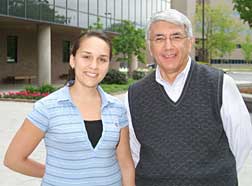Troubling link of globalization to animal and human diseases cited at veterinary college program
By Krishna Ramanujan

"Today, diseases are global," said Corrie Brown, a professor of veterinary pathology at the University of Georgia, speaking at the 2008 Smith-Kilborne Foreign Animal Disease Program at Cornell on May 28.
Globalization, said Brown, has contributed to existing diseases now appearing in new geographical areas, such as West Nile virus; to trade-generated disease such as the melamine dog-food contamination of 2006 that involved China, Canada and the United States; and to the rise in previously unknown animal and human diseases such as SARS, HIV-AIDS and BSE (bovine spongiform encephalopathy, also known as mad cow disease).
"Mad cow disease really showed us the interface between human and animal disease like never before," said Brown.
Her talk kicked off three days of lectures on foreign animal disease at Cornell's College of Veterinary Medicine during the first phase of the Smith-Kilborne program, designed to acquaint veterinary students with foreign animal diseases that potentially threaten domestic animal populations. Thirty students -- one student from each of the 28 U.S. veterinary colleges and two students from Canada -- are taking part in the program.
In the second phase, the students will travel on May 31 for two days of presentations and lab sessions at the Plum Island Animal Disease Center, a Bio-Safety Level 3 federal research facility dedicated to the study of foreign animal diseases, located off the northeastern tip of Long Island.
Brown also noted that India and China will double their gross domestic product between 2000 and 2015, meaning that people will have more money to buy food, leading to "dietary changes" within those populations; there is a "linear correlation" between income and meat and dairy consumption, she said. The increased demand for meat and dairy will lead to more trade, with developing countries producing more food and animals for export.
Therefore, globalized trade creates unique challenges since countries have different standards for animal health and monitoring and control of animal diseases, said Brown. However, she warned, exports of diseased animals can wreak havoc on industries across borders. In the case of BSE, "a case in a single infected Canadian cow" out of the million cows imported from Canada each year led to a $2 billion dollar loss for the U.S. beef industry in 2003-04. The spread of classical swine fever in the Netherlands in 1997-98 led to eight million dead hogs. Due to the low water table in the Netherlands, which made burying hogs dangerous for the water supply, the carcasses were shipped to Belgium for burial. Outbreaks of foot and mouth disease, Newcastle disease, avian flu and more have all led to catastrophic consequences for nations' meat industries.
Similarly, many emerging diseases jump from animals to humans, said Brown. The SARS virus transferred from bats to civet cats (a delicacy in southern China) to humans after the disease mutated from one species to another.
Avian influenza killed hundreds of people after victims improperly handled infected chickens, and, Brown noted, scientists fear a mutation in the virus could lead to human-to-human transmissions with the potential to spark a global pandemic.
Media Contact
Get Cornell news delivered right to your inbox.
Subscribe